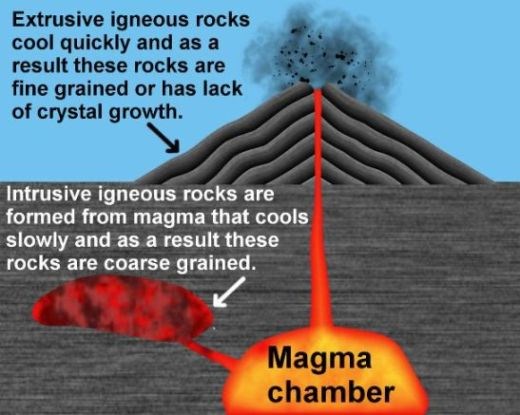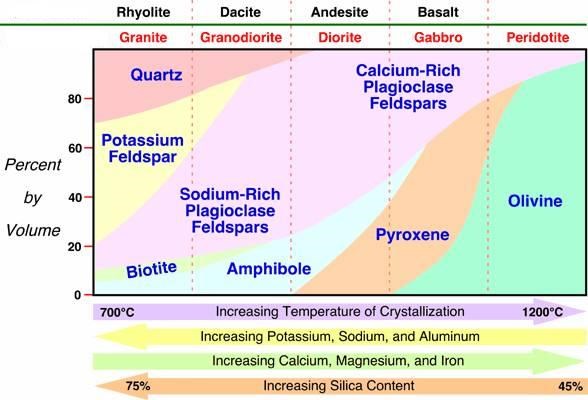HRV
Na navedenim koordinatama nalazi se Hrvatska staza slavnih. Za ovaj EarthCache zainteresirani smo za ploče na kojima su upisani slavni Hrvati. Ploče su izrađene od granita, a granit je vrsta magmatske stijene.
Magmatske stijene
Magmatske stijene jedna su od tri velike skupine stijena (druge dvije su sedimentne i metamorfne). Magmatske stijene nastaju hlađenjem vruće magme ili lave i njezinim skrućivanjem. Iako su i magma i lava u biti rastaljena stijena, magma je rastaljena stijena dok je još ispod površine, a lava je rastaljena stijena na površini planeta koju obično izbaci vulkan tijekom erupcije. Ako je stijena nastala od magme naziva se i plutonska, a ako je nastala od lave naziva se vulkanska. Termin plutonski dolazi od imena klasičnog boga podzemlja - Plutona, a termin vulkanski dolazi od činjenice da je stijena nastala od lave izbijene iz vulkana.
Igneous Rocks

Intruzivne ili ekstruzivne
Plutonske stijene nazivaju se i intruzivnim stijenama. To znači da se magma polako gura prema gore iz plašta unutar zemlje i silom upada u sve pukotine ili prostore koje može pronaći. S druge strane, vulkanske stijene nazivaju se i ekstruzivnim stijenama jer nastaju kada vruća magma ekstrudira na površinu planeta kao lava. Proces hlađenja vruće magme duboko ispod površine planeta traje puno duže od hlađenja vruće lave na površini planeta. Budući da traje duže, veći kristali mogu rasti tijekom procesa skrućivanja intruzivnih stijena u usporedbi s ekstruzivnim stijenama.
Faneritski ili Afanitski
Tijekom procesa hlađenja i skrućivanja magme ili lave, proces kristalizacije ili formiranja kristala može se, ali i ne mora dogoditi. Dakle, to znači da postoje magmatske stijene s kristalima i magmatske stijene bez kristala. Magmatske stijene koje su formirane s kristalima mogu se podijeliti na one koje imaju kristale dovoljno velike da se vide golim okom (također se nazivaju faneritske stijene), i one koje imaju kristale premale da se vide golim okom (one nazivaju se i afanitske stijene). Faneritske stijene također su intruzivne stijene, jer imaju više vremena za razvoj većih kristala tijekom hlađenja magme duboko ispod površine planeta. Afanitske stijene također su ekstruzivne stijene jer se lava hladi na površini planeta i to se događa mnogo brže nego ispod površine.
Fino, srednje ili grubo
Kristali u magmatskim stijenama vidljivi su u obliku zrna različitih boja i različitih veličina. S obzirom na veličinu zrna mogu biti: (1) sitnozrna (promjer zrna je manji od 1 milimetra), (2) srednje zrna (promjer zrna je između 1 i 5 milimetara) i (3) krupnozrnasta. -zrnasta (promjer zrna je veći od 5 milimetara). Intruzivne ili plutonske stijene obično imaju veće kristale jer proces hlađenja i skrućivanja traje puno duže ispod površine planeta. Dakle, obično su krupnozrnate. Ekstruzivne ili vulkanske stijene obično imaju manje kristale jer proces hlađenja i skrućivanja traje znatno kraće na površini planeta. Dakle, obično su sitnozrnate.
Mafične ili Felsične
Magmatske stijene mogu se kategorizirati prema svom mineralnom sastavu u dvije skupine: mafične i felsične. Mafični minerali tamne su boje, a uobičajeni mafični minerali koji tvore stijene uključuju olivin, piroksen, amfibol i biotit. Ovi minerali su silikatni minerali koji su bogati magnezijem i željezom. Izraz "mafic" izveden je korištenjem "ma-" od "magnezij" i "-fic" od "željezo". Felsički minerali su svijetle boje, a uobičajeni minerali koji tvore stijene uključuju feldspat i kvarc. Felsički minerali također su silikatni minerali, ali su bogati silicijem, kisikom, aluminijem, natrijem i kalijem. Izraz "felsic" izveden je korištenjem "fel-" od "feldspat" i "-sic" od "silica".
Mineral Composition of Igneous Rocks

Zadaci za logiranje:
Da biste zabilježili ovaj EarthCache, odgovorite na sljedeća pitanja:
Promatrajte zrnca kristala unutar gabra kako biste odgovorili na sljedeća pitanja:
1. Jesu li ove ploče izrađene od faneritske stijene ili afanitske stijene? Zašto?
2. Sadrže li ove ploče sitnozrnatu, srednje zrnatu ili krupnozrnat stijenu? Zašto?
3. Je li ovaj granit formiran duboko ispod površine planeta ili na površini planeta? Zašto?
4. Je li ovaj granit nastao od magme ili lave? Zašto?
5. Promatrajte boju granita. Je li to mafična ili felsična stijena? Zašto?
6. Priložite svoju fotografiju, svoj GPS ili nadimak napisan na papiru, dlanu, majici i sl.
Pošaljite odgovore putem profila na geocaching.com, NE u svom dnevniku! Ne morate čekati da Vaši odgovori budu potvrđeni. Nakon što pošaljete svoje odgovore, slobodno zabilježite ovaj EarthCache kao pronađen. Ako su vaši odgovori pogrešni, kontaktirat ćemo vas.
ENG
At the listed coordinates you will find Croatian Walk of Fame. For this EarthCache we are interested for plaques on which are enlisted famous Croatians. Plaques are made of granite, and granite is type of igneous rock.
Igneous Rocks
Igneous rocks are one of three large groups of rocks (the other two are sedimentary and metamorphic). Igneous rocks are formed by cooling of hot magma or lava and by its solidification. Although both magma and lava are essentially molten rock, the magma is molten rock while it is still below the surface and lava is molten rock on the surface of planet usually expelled by a volcano during an eruption. If the rock is formed from magma it is also called plutonic and if it is formed from lava it is called volcanic. The term “plutonic” came from the name of classical god of the underworld - Pluto, and the term “volcanic” came from the fact that the rock is formed from lava erupted from a volcano.
Igneous Rocks

Intrusive or Extrusive
Plutonic rocks are also called intrusive rocks. That means that magma is slowly pushed up from the mantle within the earth and it intrudes by force into any cracks or spaces it can find. On the other hand, volcanic rocks are also called extrusive rocks because they are formed when hot magma extrudes onto the surface of planet as lava. The process of cooling of hot magma deep below surface of planet lasts much longer than cooling of hot lava on the surface of planet. Since it lasts longer, the larger crystals can grow during the process of solidification of intrusive rocks when compared to extrusive rocks.
Phaneritic or Aphanitic
During the process of cooling and solidification of magma or lava, the process of crystallization or formation of crystals might or might not happen. So, that means that there are igneous rocks with crystals and igneous rocks without crystals. Those igneous rocks that are formed with crystals can be divided into those that have crystals large enough to be seen by the naked eye (they are also called phaneritic rocks), and those that have crystals too small to be seen by the naked eye (they are also called aphanitic rocks). Phaneritic rocks are also intrusive rocks, because they have more time to develop larger crystals during cooling of magma deep below surface of planet. Aphanitic rocks are also extrusive rocks because lava cools on surface of the planet and it happens much faster than below surface.
Fine, Medium or Coarse
Crystals in igneous rocks are seen in the form of grains of different colors and different sizes. Regarding their size, grains can be: (1) fine-grained (diameter of the grains is smaller than 1 millimeter), (2) medium-grained (diameter of the grains is between 1 and 5 millimeters), and (3) coarse-grained (diameter of the grains is larger than 5 millimeters). Intrusive or plutonic rocks usually have larger crystals because the process of cooling and solidification lasts much longer below the surface of planet. So, they are usually coarse-grained. Extrusive or volcanic rocks usually have smaller crystals because the process of cooling and solidification lasts much shorter on the surface of planet. So, they are usually fine-grained.
Mafic or Felsic
Igneous rocks can be categorized according to their mineral composition into two groups: mafic and felsic. Mafic minerals are dark in color, and common rock-forming mafic minerals include olivine, pyroxene, amphibole, and biotite. These minerals are silicate minerals that are rich in magnesium and iron. The term “mafic” is derived from using the “ma-“ from “magnesium” and the “-fic” from the “ferric”. Felsic minerals are light in color, and common rock-forming minerals include feldspar and quartz. Felsic minerals are also silicate minerals but they are rich in silicon, oxygen, aluminium, sodium, and potassium. The term “felsic” is derived from using the “fel-“ from “feldspar” and “-sic” from “silica”.
Mineral Composition of Igneous Rocks

Logging Tasks
To log this EarthCache answer the following questions:
Observe the grains of crystals within gabbro to answer the following questions:
1. Are these plaques made of phaneritic rock or aphanitic rock? Why?
2. Do these plaques containe fine-grained, medium-grained or coarse-grained rock? Why?
3. Is this granite formed deep below the surface of planet or on the surface of planet? Why?
4. Is this granite formed from magma or from lava? Why?
5. Observe the color of the granite. Is it mafic or felsic rock? Why?
6. Attach a photo of you, your GPS or nickname written on paper, palm, t-shirt, etc.
Send answers via profile on geocaching.com, NOT in your log! You do not have to wait for your answers to be confirmed. Once you submit your answers feel free to log this EarthCache as found. If your answers are wrong we will contact you.